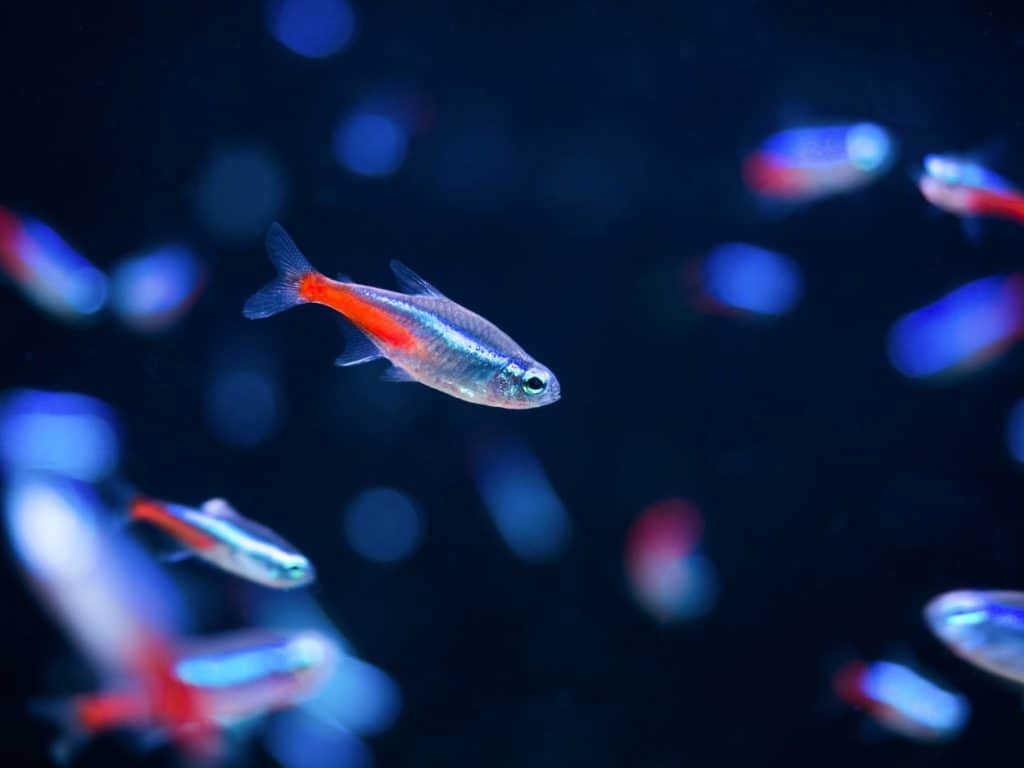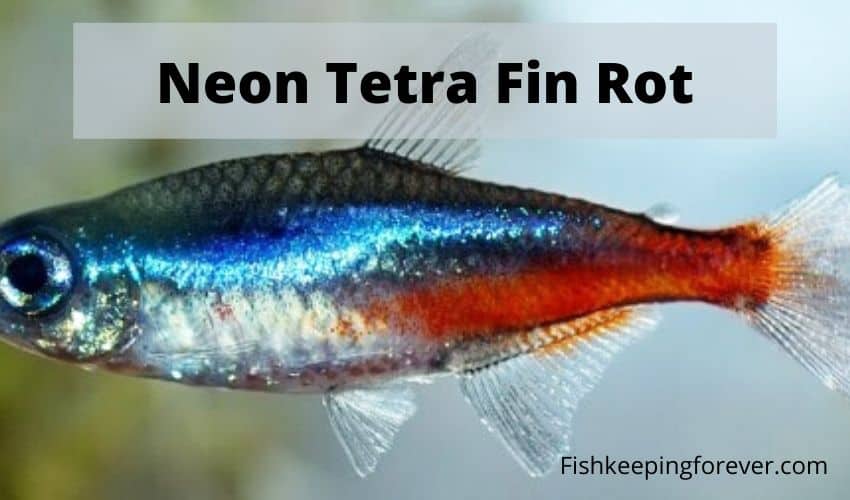With their neon coloration and nippy swimming, Neon Tetras are an incredibly popular aquarium addition. They are stunning when kept in larger shoals and, in general, easy to care for.
Ease of care, however, doesn’t necessarily equate to the Neon Tetra being completely problem-free. In fact, they are prone to, though not more so than any other species, common fish diseases such as the dreaded fin rot!
What is neon tetra fin rot? Neon tetra fin rot can be caused by several different species of bacteria, such as Aeromonas, pseudomonas, and vibrio, but the source is always, in nature, environmental. It is often related to stress from situations that the aquarium keeper has put them in.
Table of Contents
What Is Fin Rot?
Fin rot is one of the most common and yet preventable diseases that you may find in an aquarium. And is a common disease within neons. Neon tetra fin rot can be caused by several different species of bacteria, such as Aeromonas, pseudomonas, and vibrio, but the source is always, in nature, environmental. It is often related to stress from situations that the aquarium keeper has put them in.
Though reasonably easy to prevent, fin rot can be incredibly difficult to cure once it has set in. Fin rot in Neon Tetras really does suit the proverbial saying ‘prevention is better than cure!’ If left untreated, fin rot can and probably will eventually kill the diseased fish, as well as infecting all the other fish in the aquarium too.

What Are The Symptoms Of Fin Rot?
During the early stages of fin rot, it can be difficult to notice as the changes in your Neon Tetra’s appearance will be subtle. The edge of the fin will begin to discolor and take on a milky hue. As the infection spreads, however, small pieces of their fins will begin to fall off leaving the ragged edging indicative of fin rot.
Over time, if left untreated, the fins of the Neon Tetra will get shorter and shorter as dead flesh begins to fall off. Sadly this is common within neon tetra fin rot symptoms. The area may also become inflamed and red with bloody patches appearing as more tissue is eaten away.
It is also common for a secondary fungal infection to develop along the raw edges of the fin as well as Columnaris (cotton-wool) bacteria. This is due to Columnaris and secondary infections being caused by very similar environmental factors.
What Are The Causes Of Fin Rot In Neon Tetras?
As previously mentioned, stress is one of the most common causes of fin rot in Neon Tetras. Stress can be due to a number of factors including overcrowding, overfeeding, moving or handling your fish, and putting them in an aquarium with more aggressive species. Poor water quality is also another common cause. This could be due to the temperature being too low, too high, or poor aquarium maintenance.
How Do You Prevent Fin Rot In Neon Tetras?
Many of the measures you would take to prevent neon tetra fin rot are the same as those you would take to treat it, starting with good aquarium maintenance. You should, for example, make sure that you perform regular water changes, as well as vacuuming the gravel regularly, and monitoring your water chemistry by having a regular testing schedule. Document the results of your water tests as this will help you quickly notice any changes over time. See some of our recommended test kits on Amazon here!
As well as regular maintenance, you should take care of your Neon Tetras feeding and schedule. Only feed as much as they can eat in around three minutes and keep this to twice a day. Overfeeding is one of the most common mistakes that aquarists make and also one of the biggest contributors to poor water quality that breeds bacteria.
Also, avoid stress which can be induced by overcrowding or housing your Neon Tetras with other species they may not be compatible with. Fish fighting or nipping at each other’s fins can leave them more susceptible to fin rot.

How Do You Treat Neon Tetra Fin Rot?
There are several antibiotic treatments available on the market that can be very effective in treating Neon Tetras fin rot. These can be purchased from pet stores, specialist aquatic stores, and online from sites such as Amazon. Always read the advice included in the medication and follow the instructions carefully as they will vary brand to brand.
You can also include, in your treatment, the addition of aquarium salt. Simply add one teaspoon of salt for every gallon of water. We would not, however, recommend treating Neon Tetras in a salt bath as the moving of the fish could be stressful.
Addressing The Root Cause
Treating your Neon Tetras for fin rot is all well and good, but if you don’t also address the root cause you will never get rid of the problem. Preventative measures, as detailed above, should be taken to ensure that you provide an environment that will not only aid in curing fin rot, but also prevent it in the future.
When It’s Not Just Fin Rot!
Sometimes, fin rot, unfortunately, is not just fin rot! It could also be the sign of another more serious condition known as Neon Tetra Disease. This is not, contrary to its name, a disease just suffered by Neon Tetras, but rather it is named so because it was first found in this species.
Neon Tetra disease is caused by a microsporidian parasite that has fin rot as a secondary symptom. It is a degenerative disease that starts mildly but progresses swiftly and becomes extremely severe. In order the symptoms are:
- Restlessness
- Loss of color (one part of the body)
- Muscle cysts (appearing as lumps on the body)
- Difficulty swimming
- Curvature of the spine
- Bloating
- Fin rot
More About Neon Tetra Disease
Caused by a parasite called Pleistophora Hyphessobryconus, Neon Tetra disease will eat a fish from the inside out. It does this via a spore which enters the fish through ingesting the bodies of dead fish or eating contaminated food. The above symptoms will then develop, one by one, ending with fin rot.
It is important to know that Neon Tetra disease is highly communicable and can spread throughout an aquarium very quickly. There is no known cure, most fish will die from it, and if you believe your fish may be showing symptoms you should separate them from the others immediately.
Preventing Neon Tetra fin rot or neon tetra disease in general is all about not buying sick fish and maintaining high water quality. You should also ensure that you purchase high-quality foods from a respected source.
Other Diseases To Watch Out For
Dropsy – A bacterial infection of the kidneys which causes fluid accumulation or renal failure. It usually appears in already weakened fish and can be recognized by its characteristics of bloating and protruding scales.
Ick – Another disease that usually attacks fish that are already stressed. It can be caused by factors such as rapid temperature and pH fluctuations. It appears as white spots and clamped fins with the fish rubbing itself on surfaces and gasping for air at the surface.
Clamped Fins – It can be difficult to discern the cause of clamped fins as it is usually a reflection of other problems. The fins of the fish will fold against the body and it will display listless behavior.
Fungus – Fish who develop fungus are usually already in a vulnerable state as a result of other serious health problems. Generally, these will be related to parasites, physical injury, or bacterial infection. The fungus will appear as a gray to whitish growth on the skin or fins that resemble a cottony growth.
- Comparing Aquarium Gravel To Sand – Which Is Best For Your Tank?
- Silver Arowana: Complete, Care, Breeding, Feeding Guide
- Rainbow Shark: Diet | Size | Breeding | Cost
- Tiger Barb Fish: Diet | Breeding | Size | Water Conditions
- Jack Dempsey: Diet | Size | Breeding | Lifespan | Sexing | Care Guide

I have been working in the tropical fish industry for over 30 years now and I’m still learning. Everyday is a school day in this hobby. In my spare time I play golf very badly!



